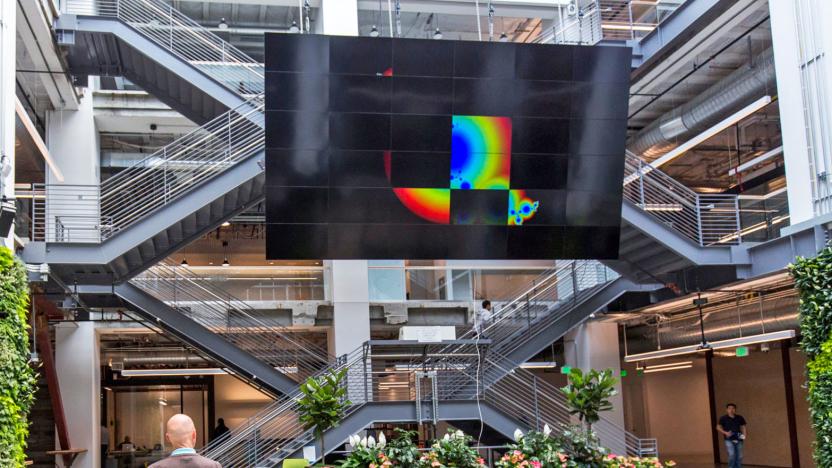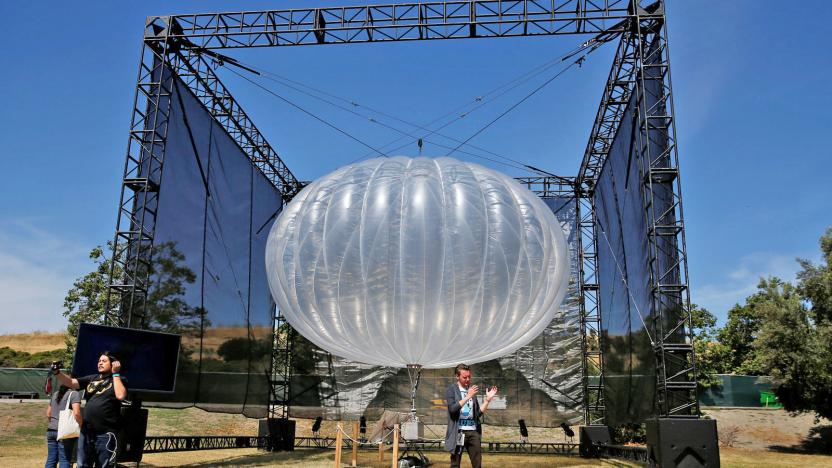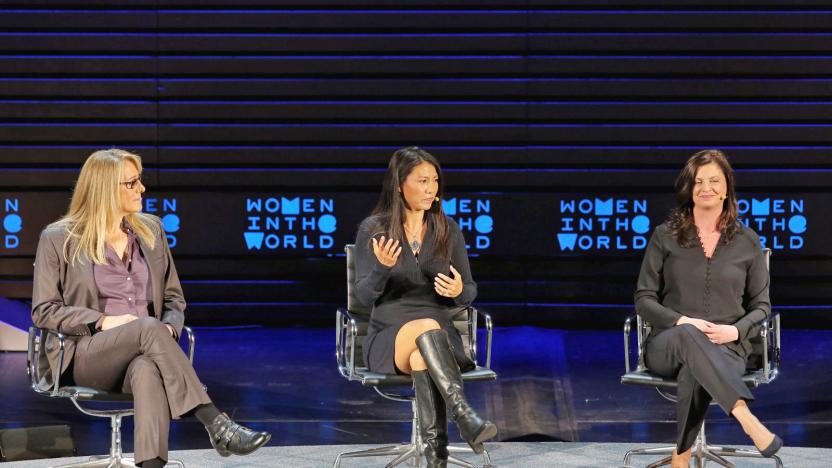googlex
Latest

Inside Chronicle, Alphabet’s cybersecurity moonshot
Fifteen years ago, cybersecurity could be boiled down to a simple strategy: Secure the perimeter. Experts fought against malware and other nefarious code by implementing firewalls and other point-of-entry defenses. Since then, however, companies have moved their operations online and allowed employees to bring their own devices (BYOD) to work. The so-called perimeter has dissolved in the process, forcing security practitioners to prioritize tracking, understanding and ultimately making judgments about the information flowing both inside and outside of their company.

Alphabet exec Rich DeVaul resigns after harassment allegation
Just days after a New York Times report dug into sexual misconduct by executives within Google and its parent company Alphabet, one of the men named has resigned. Rich DeVaul was a director of Alphabet's X research division (formerly known as Google X), and cofounded Project Loon. As first reported by Axios, DeVaul resigned, and did not receive an exit package.

How Dandelion is making geothermal heating affordable
Millions of US citizens still use oil and natural gas to heat their homes during the winter. Many would like to switch to geothermal, a cleaner and ultimately cheaper system that leverages the natural temperature of the earth. A few feet below the surface, the soil sits at a reliable 50- to 60-degree Fahrenheit all year round. Pipes known as 'ground loops' push round a special antifreeze solution that absorbs this constant temperature in winter and disperses unwanted warmth in the summer. A large indoor heat pump uses the mixture to boil a refrigerant fluid; the resulting gas is then compressed to higher temperatures and distributed around the home. Installing the necessary equipment is expensive, however. Dandelion, a company that started inside Alphabet's X division, is trying to make geothermal cheaper and easier to install. While not the most eye-catching technology, especially compared to electric cars and sea-cooled data centers, it's arguably one of the most important for the environment.

Alphabet won't need all those internet balloons after all
Since it launched nearly four years ago, Alphabet's Project Loon experiment has shifted from an unlikely moonshot to an idea that might actually work. As Alphabet's experimental X division chief and "Captain of Moonshots" Astro Teller wrote today, the project team has "now exceeded even their own expectations," in the attempts to build a network of self-navigating, internet-beaming balloons. "And in the process they've leapt much closer to a day when balloon-powered Internet could become a reality for people in rural and remote regions of the globe."

Google X co-founder Yoky Matsuoka returns to Nest
Silicon Valley's most in-demand robotics professor has returned to Alphabet Inc.'s Nest. As Recode reports Monday, Yoky Matsuoka will step back into the Google fold as Chief Technology Officer at the smart home devices company.

Alphabet dropped its plan for solar-powered internet drones
Wondering what happened to Google's solar internet drone project? Unfortunately, we don't have good news. An Alphabet spokesperson has confirmed to 9to5Google that its X division quietly dropped the Titan project shortly after it folded into X in late 2015. It won't surprise you as to why: Project Loon's high-altitude balloons are a "much more promising" way of getting people online in remote locations, the company says. Staffers who were working on Titan have found their way into other "high flying" initiatives, such as Project Loon and Project Wing. You can read the full statement below.

Chris Urmson leaves Google's self-driving car project
After seven and a half years working on self-driving car tech for Google/Alphabet, Chris Urmson announced his departure from the team in a blog post tonight. He took over as director after Google X founder Sebastian Thrun left in 2013, and led until Google hired former Hyundai exec John Krafcik as the CEO of its car division. The New York Times reports Urmson was unhappy with the recent direction of the project under Krafcik and had "quarreled" with Larry Page, however his post simply says he's "ready for a fresh challenge."

Oculus exec Mary Lou Jepsen resigns to create new MRI tech
Dr. Mary Lou Jepsen is well known for her work in pioneering display technology as a co-founder of OLPC, former head of the display division at Google X and lately Oculus VR, which she joined about a year ago. Tonight during the Anita Borg Institute's Women of Vision awards banquet, the founder and former CEO of Pixel Qi capped off a keynote speech by announcing she will resign her post as Executive Director of Engineering and Head of Display Technologies at Oculus. Instead, she will focus on "curing diseases with new display technology," by bringing MRI machines to every doctor' office in the world. It's an ambitious goal, but a peek at Dr. Jepsen's history shows why she's the person to tackle it. For more info on what she might be working on, there's video of a recent TED talk with Dr. Jepsen discussing MRI and fMRI tech, which you can watch after the break.

Schaft's latest robot looks positively interstellar
Alphabet's intent to get rid of Boston Dynamics hasn't affected its other robotics programs, from the looks of it. On Japan's New Economic Summit stage, the Alphabet X lab (formerly Google X) subsidiary SCHAFT unveiled a new bipedal unit that's capable of climbing stairs, carrying a loaded barbell on its "head" unit, laterally stepping through a row of seats at a soccer stadium and even maintaining balance when a section of pipe is placed under its feel. IEEE Spectrum writes that this was part of former Google exec Andy Rubin's keynote at the event, but that the debut wasn't part of a product announcement or "indication of a specific product roadmap."

NYT: Alphabet's reorganized 'X' division now includes robots
Last year Google shipped off some of its wilder projects for administration under new parent company Alphabet, which included its efforts with robots and the lab formerly known as Google X. A New York Times report says that the latter, now just known as the X research division, is in control of the disparate robotics projects acquired by Andy Rubin. To help manage the team, a former Nokia exec (with some interesting ideas about how Android can beat iPhone) named Hans Peter Brøndmo also joined up this month.

ICYMI: Insect robot for kids, paralysis fixed and more
#fivemin-widget-blogsmith-image-184110{display:none;} .cke_show_borders #fivemin-widget-blogsmith-image-184110, #postcontentcontainer #fivemin-widget-blogsmith-image-184110{width:570px;display:block;} try{document.getElementById("fivemin-widget-blogsmith-image-184110").style.display="none";}catch(e){}Today on In Case You Missed It: We are covering the drone guideline news from the FAA the only way we know how: With some silly videos and real ones as well, like the Google X drone delivery test video -- all to warn you all that UAV regulations are finally coming. A new Kickstarter for a toy insect robot comes with origami-like assembly, to teach kids about coding and engineering. And scientists at Ohio's Case Western Reserve University have electronically bridged a gap between a paralyzed person's spinal column and arms using brain wave sensors, in effect letting him use his arms once again.

Google registers two delivery drones for US testing (update)
Google X's Project Wing concept was a unique take on the delivery drone: a single-winged UAV that took off and landed vertically. Despite extensive testing in Australia, the plan didn't work as well as the company hoped. In March this year Google X head Astro Teller announced the organization was working on a new design, and now, FAA documents show that two Google-built UAVs, codenamed the M2 and the B3, have been registered this month in the US. The M2 made the FAA registry on October 2nd, while the B3 was listed October 7th.

Google is now Alphabet, the owner of Google
The paperwork is filed and it's official: Google has restructured itself into Alphabet. As of the close of business today shares of the old Google are now part of Alphabet, which counts Google as a subsidiary. On our end, this doesn't change much -- unless you're a big fan of Ingress or Pokemon -- but now Sergey Brin and Larry Page can chase innovations in seemingly unrelated areas. Sundar Pichai will keep running day-to-day operations at the new Google, except now with the title of CEO. Google now includes Android, Search, YouTube, Apps, Maps and Ads. Meanwhile, Alphabet can focus on Google Fiber (high speed internet), Calico and Life Sciences (health), Google Ventures and Google Capital (investments), Nest (home automation) and Google X (everything fun, like drone deliveries, self-driving cars and city-wide WiFi). [Image credit: Jeff Chiu/Associated Press]

Video series gives you a rare peek into Google's world
As open as Google is about its plans, it doesn't say much about what it's like to actually work there. Just what are those engineers doing every day? Googlers Nat and Lo might just answer that for you. They've kicked off The 20% Project, a video series that explores some of the behind-the-scenes action in Mountain View and beyond. The first two episodes delve into work on the Street View Trekker as well as what Google X's Design Kitchen does (spoiler: it breaks a lot of early prototypes). Future shows will explore things as exotic as self-driving cars. You're not going to learn about any secret projects, but this is fascinating stuff if you've ever wished that Google would give the public more than blog posts and glitzy promo clips.

Google could build a hoverboard, but won't
Buried deep in the bowels of Google's top-secret X lab is the technology that could, theoretically, enable us to all have a Back to the Future-style hoverboard. Unfortunately, according to the lab's director of moonshots, that's where it's going to stay, disappointing all of the bullied nerds of Hill Valley. Obi Felten revealed at the Hello Tomorrow conference in Paris that researchers had successfully developed a method to "levitate carbon on magnets," but that it struggled to see that too many people would actually want such a device. Yeah, we know.

Google's new health watch will keep tabs on patients' vitals
Google unveiled a new wearable today, though it won't be competing with the Apple Watch any time soon. Developed by Google X (the company's advanced research division), the experimental device is geared specifically for clinical research. It monitors not just the wearer's stats (including pulse, heart rhythm and temperature) but also environmental variables like light and noise levels as well.

Google teams with Johnson & Johnson for robotic-assisted surgery
Google's mysterious facility, Google X, is churning out next level technologies -- a self-driving car, delivery drones and Internet balloons. Its Life Sciences division is now teaming up with Ethicon, one of Johnson & Johnson's medical device companies, to develop robotic-assisted surgeries. "Through this collaboration, we are looking to provide surgeons with a technologically advanced system that would help them make the best, most informed decisions," Gary Pruden, Worldwide Chairman, Global Surgery Group at Johnson & Johnson told Engadget. "The surgeon remains the ultimate decision maker, but they will have even more support with precision movements and data-enhanced decision making tools."

Google ditched the steering wheel because people are unreliable
If you've ever wondered why Google decided to build its own car, well, you have at least part of your answer now. During a talk at SXSW, Astro Teller, the head of Google X, told the crowd that they decided to remove the steering wheel and brakes entirely because humans are not a "reliable backup" for the self-driving system. What does he mean exactly? Well, he believes that Google has already "mastered" highway driving. The company had put in hundreds of thousands of hours, autonomously cruising California freeways. The project had even reached the dog-fooding phase, in which Googlers test out the project in the real world. So employees that didn't work in the semi-secretive Google X division were essentially invited to beta test the vehicle and commute to work in a robot car -- under the condition that they pay very close attention and be the world's best bug reporters.

Google needs partners to actually build its self-driving car
After helping push the entire automotive industry forward when it comes to autonomous driving, it appears Google is ready for some help with its own driverless cars. As the leader of the project told The Wall Street Journal, the folks in Mountain View aren't looking to replicate what Detroit-based and international automakers do best (build vehicles from the ground up). It's looking for an established player to help shoulder the load and bring the Google rides to market in the next five years. Until that happens, Chris Urmson says his team is partnering with automotive suppliers to move three generations beyond the cartoony-looking prototypes (pictured above) it has now. What's more, the search giant plans to on-road test this "beta one" fleet early next year. For California's sake, let's hope they're just as adept at sensing cyclists as their predecessors.

Project Loon works with France's space agency to develop next-gen balloons
Project Loon has come a long way since Google X started working on it in 2011: its balloons can now stay afloat for 100 days, for one, and it has recently gained a partner carrier in Australia's Telstra. Now, France's space agency, Centre National d'Etudes Spatiales (CNES), has revealed that it's been collaborating with the semi-secret lab for a year now to take this moonshot to the next level. Apparently, the agency is helping Mountain View analyze data from ongoing tests, as well as design its next-gen floating hotspots. Google, on the other hand, will help CNES conduct long-haul balloon flights to the stratosphere.










